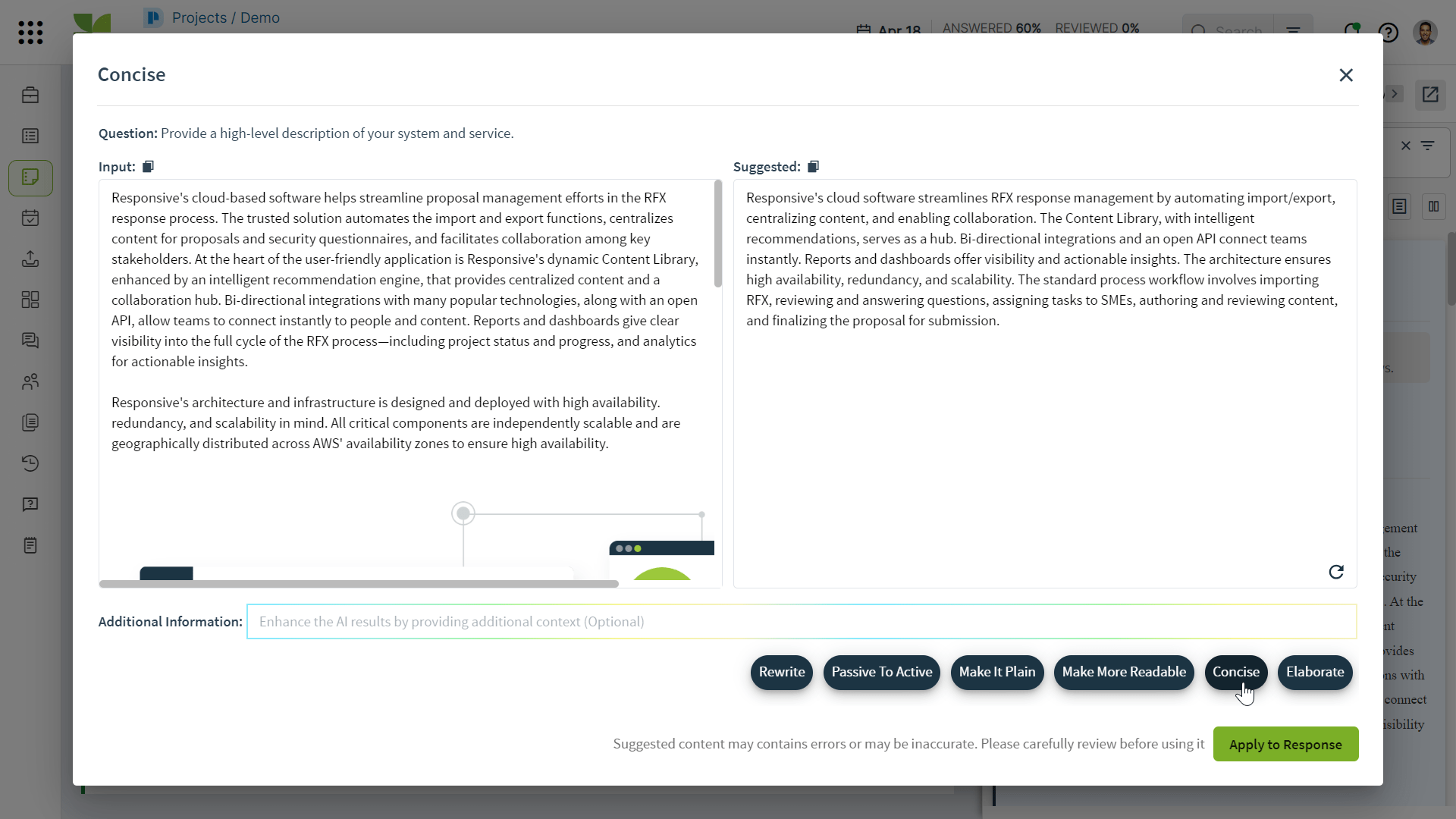Company knowledge is your competitive differentiator. How it’s curated, leveraged, and accessed reverberates throughout every facet of your organization, from solution development to end-user training, and from proposal management to sales success.
Difficulty finding or accessing company knowledge is one of the most common roadblocks to productivity. In a study conducted by Forrester® Research, sales professionals cited the ability to find content or information as the number one area in need of improvement to be more productive, especially in remote work environments.
Knowledge management and content management are ubiquitous challenges for organizations of all sizes. Many software and cloud-based XaaS solutions exist to support optimization initiatives, but there’s an upstart sector that’s focusing on bringing your company knowledge to life.
Known as strategic response management, it’s the next evolutionary step beyond RFP response automation. While it’s well-established with proposal teams around the world, strategic response management’s knowledge and content governance capabilities are growing in popularity with sales, pre-sales, InfoSec, customer support, legal, and other teams that rely on accurate, accessible company knowledge to be productive.
Recently, Louise Fahey, Senior Proposal Manager at Mambu, a SaaS cloud-banking platform based in Amsterdam, sat down with a Responsive (formerly RFPIO) representative to discuss how the software helped to bring Mambu’s knowledge to life. This interview took place during the BPC Europe conference hosted by the Association of Proposal Management Professionals (APMP) in Amsterdam.
In the interview transcript that follows (edited for length and clarity), Louise at Mambu and Responsive’s Vice President of International Sales discuss:
- How proposal automation capabilities of strategic response management software saves time, both professionally and personally
- Why content governance is such an important process within knowledge management
- How quickly other teams recognize the value of knowledge management using strategic response management software
- Why it’s so easy for new teams, new users, and new hires to start using the software to access and leverage company knowledge
Responsive (VP of International Sales): I would like to invite one of our customers, Louise from Mambu. She’s here to share her knowledge on how she’s bringing knowledge to life at her company. I understand that at your previous company, once a lifetime ago, you were actually a technical writer. So what encouraged you, what motivated you to actually move into proposal management?
Mambu (Louise Fahey, Senior Proposal Manager): The main reason I moved was the impact that I felt I could have as a proposal manager. I like to use a lifeguard analogy; people only notice the lifeguard when they’re not there. And it’s the same with the proposal manager. You notice when they’re not there and start wondering, “How are we going to manage this deadline with the amount of work that needs to be done?”
There are also a lot of transferable skills between technical writing and proposal management – both roles cover content management, dealing with stakeholders, getting reviews, and managing deadlines. So it was a comfortable transition.
Responsive: Once upon a time, several years ago, there really wasn’t any software out there that was available to eliminate repetitive tasks. Like actually the company’s headquarters, the number of employees, PCI certification, and so on were a little monotonous. How did you actually feel once you had to do these repetitive tests and under pressure?
Mambu: It was quite frustrating and you questioned the amount of time that was spent copying and pasting into a Word document. Each proposal began to feel a bit like Groundhog Day!
It felt a bit unfulfilling and I started to think, “I can do more than this… I understand the customer’s hot buttons and strategy.” I can add more value to the proposal than just copying and pasting.
Resposive: So you’ve now seen the light, and you’ve moved away from this random process, and you’re using a strategic response management software. So you were truly bringing the company knowledge to life. So did you ever feel like you were drowning?
Mambu: I can think of a few occasions.
When you work with a team in a different time zone or you have a tight submission deadline; you’re up until midnight and you know everything has to be submitted by 2:00 PM the next day. You feel like you’re drowning.
Another example is when you have so much content to manage. There’s a library of past responses and when a new proposal comes in, you need to query this library to get the information you need. However, when you start using the search functionality in SharePoint, or whatever repository your documents are hosted in, it doesn’t give you the results you need. That’s another example of drowning; not having the opportunities to adequately search for the answers you need.
Responsive: How would you say morale has improved since adopting a strategic response management software? Not just the proposal managers, but also the company stakeholders?
Mambu: It has definitely improved a lot, especially amongst our solution engineers (technical sales team). They’re seeing the value because they used to manually fill in proposals.
We also use (Responsive) in other parts of the organization, including information security, and assurance teams. They use it to keep their content up to date. Now when we get something like a due diligence questionnaire, it’s easier for those teams to manage as well. It’s game-changing for not just the sales team, but the company as well.
Responsive: So have they reduced the amount of time that people come to you for answers and improve the quality of those answers? Do SMEs really like them?
Mambu: Yes, definitely. We’ve had a lot less of the same repetitive questions. And it’s not just the Proposal Management team who are dealing with fewer questions, it’s other teams in the organization.
In my previous answer, I mentioned that the information security team uses Responsive – they’re saving time by using their Slack channel to direct people with questions to Responsive, where they can find answers.
Responsive: What was the biggest learning curve switching from Excel to strategic response management software?
Mambu: I think it’s the same as with any other new solution — finding where everything is in the UI takes some getting used to. But the more proposals you do in Responsive, the better you get.
It’s important to find a solution with really good support, in case you find the learning curve steep. With Responsive, we have a customer success manager who is there to help. Plus the support team and online help are also excellent.
Responsive: So now that you don’t have to work holidays, what are you able to spend more time on?
Mambu: Now that we have Responsive in place; there’s more time to focus on process improvements, managing our content library better, and also my own career development. It also means we have extra time to create more personalized responses to our RFx.
Personally, it’s also been quite game-changing. Thanks to the efficiencies that come from having a proposal management solution in place, I’m less likely to work evenings — I get to spend more time with family and friends.
Responsive: How have you made better decisions using Responsive?
Mambu: We’ve made better decisions as a result of how good our content library is. In the past, I’d have to remember which proposal from 6 months ago had a really good response to a certain question. Now we have a library of good responses and that enables us to make better decisions.
In addition, the project management part of (Responsive) takes some of the pressure and stress off and streamlines the process, allowing you to make better decisions.
Responsive: What would be your number one piece of advice about bringing your company knowledge to life?
Mambu: Putting content into your Responsive library is only the start. Your content is a living thing. Make sure you get ownership from content reviewers and subject matter experts. Always set your review cycles and then follow up. It’s too much for one person and even one team to keep an entire library of content up to date; getting ownership from outside the proposal management team is important too.
We have added Responsive to the onboarding process for new employees. They receive training on how to use it, and we’re also working on some e-learning videos to further this process.
Responsive: I like that last one, probably the most; you talked about bringing company knowledge to life.
A lot of us work at companies where there’s truth, people leave their jobs; like with the great resignation. So you’re bringing in new hires, what’s the fastest way to train on this? So if you have a tool now, use that to share the company knowledge, and that way you save time, because you’re not getting the same question 10 different times.
What advice do you have in regard to best practices or approaches to content management?
Mambu: Let’s talk about content governance. First step is to document the process itself, how we want to manage our content. Once you have your list of subject matter experts, enable them to use Responsive. I think that’s really important.
It’s not enough for you or your immediate team to believe you’ve got this great proposal management software and that your subject matter experts will love using it to keep content up to date. In reality, don’t be surprised to hear them respond with, “I’ve got 100 other things to do, and I’m not doing this.”
You need to show them the value of using the tool — what’s in it for them? It could be the time saved because they’re not answering the same question multiple times for different people. Or the relief in knowing that the sales team is using an approved response from the content library to answer queries from prospects.
Our content library is tagged by different topics, such as InfoSec, support, implementation, and so on. We have reviewers assigned to our content, and tags help make this process easier. We can even schedule the review process, so reviewers automatically receive a notification about when they need to do the review. And there’s also functionality for adding comments so it can be screened at each step.
We also made it really easy for people outside our team to contact us about Responsive. We have a dedicated Slack channel where people can ask us questions. And we present Responsive to the solution engineering and sales teams, making it clear that the proposal management team is here to support them with it.
This helps a lot with content governance; getting that initial buy-in by showing the value of Responsive, and then providing support to users afterwards.
[END OF INTERVIEW]
Learn more about how Responsive can help with knowledge management and content governance by requesting a demo today.





